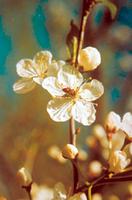

Seed Plants
Seed Plants, the most abundant and familiar component of Earth's vegetation, comprise an estimated 250 000-300 000 species. They outnumber all other PLANT groups, dominate the land, thrive in bodies of fresh water and are found to a limited extent in the oceans. They include the largest (giant sequoia) and oldest (bristlecone pine) living things, and encompass tiny water-meal scarcely 1 mm long and ephemeral annuals that survive only a few weeks. Seed plants share with other vascular plants (plants with woody conducting systems) basic organs (root, stem and leaf), cell types and tissues. In response to different environments, they have evolved many forms.Reproduction
The common feature uniting seed plants is the "seed habit," a unique method of sexual reproduction. In all vascular plants, the conspicuous plant is a spore producer (sporophyte) that alternates, in the life cycle, with a sexual phase (gametophyte). In seed plants, the spore that produces the female gametophyte is not shed to initiate an independent plant but is retained in the sporangium (reproductive structure), which is surrounded by a protective covering (integument). This is the immature seed or ovule.
Spores that produce male gametophytes are released as the gametophytes begin to develop. These are the pollen grains which are transferred to the ovules where fertilization is completed, resulting in seed development. The EVOLUTION of this method of reproduction, more than 350 million years ago, was one of the most significant steps in the adaptation of plants to life on land.
MOSSES and lower vascular plants (eg, FERNS), like their aquatic ancestors, release sperm that must swim through water to effect fertilization. Seed plants are freed from this dependence on water.
Gymnosperms
Gymnosperms, the more ancient group of seed plants, include CONIFERS, cycads and the maidenhair tree (Ginkgo). Although there are only about 800 living species, gymnosperms are important in the flora of many areas (eg, boreal forest). The FOSSIL record shows that they were much more important in the past, and included several now-extinct forms (eg, seed ferns). Pollen and ovules are produced in separate cones. Pollen grains are transferred directly to ovules, ultimately being drawn inside through an opening in the integument. Thus the ovules are exposed at the time of pollination (gymnosperm means "naked seed"), although usually enclosed later by growth of the cone scales. In the mature seed, the embryo is embedded in a nutritive tissue that is actually the female gametophyte.
Angiosperms
The angiosperms, flowering plants, have dominated Earth's vegetation since the Cretaceous period (144.2-65 million years ago). Their distinctive reproductive structure, the flower, occurs in diverse forms related to different methods of pollination. Pollen and ovules may be found in the same or separate flowers. Pollen is produced in stamens. Ovules are formed inside the pistil; they are not exposed at the time of pollination (angiosperm means "vessel seed"). Pollen is transferred to a receptive surface on the pistil where it germinates; sperm are carried into the ovule by growth of the pollen tube. Seeds mature inside the pistil, which becomes the fruit. Some one-seeded fruits (eg, cereal grains) are often confused with seeds.
The nutritive tissue of the angiosperm seed is a new tissue, endosperm, which with the embryo results from the fertilization process. The endosperm frequently is absorbed by the embryo before the seed is mature. There are 2 major evolutionary lines of angiosperms: monocotyledons, with flower parts usually in threes, major leaf veins parallel and only one cotyledon (embryo leaf); and dicotyledons, with flower parts usually in fours or fives, net-veined leaves and 2 cotyledons.
Economic Importance
The economic significance of seed plants cannot be overemphasized. Angiosperms provide most of our important food CROPS (seeGRASS) and produce spices, drugs, fibres, timber and industrial raw materials. Gymnosperms (conifers) are major sources of wood products; seeds of a few (eg, pinyon pine) are minor food sources.

 Share on Facebook
Share on Facebook Share on X
Share on X Share by Email
Share by Email Share on Google Classroom
Share on Google Classroom

